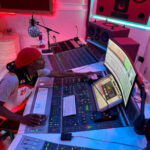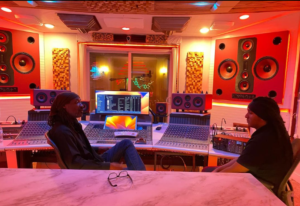Imagine watching a film without the eerie ambiance during a horror scene. How will you feel? Would it feel the same impact as it used to have with the bass? Probably not.
This is the power of sound design. In this blog, we will explore how sound design in music production can elevate your tracks. Plus, how it can help you craft unique sounds that captivate listeners.
What Is Sound Design?
Sound design refers to the process of how to create and manipulate sounds, and audio elements. The process involves different procedures including synthesizing new sounds, altering the recorded sounds, and layering textures. In order to achieve the particular mood, and tone that you and your music need.
Sound design helps you get your hands on a lot of different sound textures. Doesn’t matter whether it is a signature lead in an EDM, a versatile effect in a hip-hop song, or a textured pad in a cinematic piece. Many professionals working at the best recording studios in Atlanta utilize these advanced sound design techniques to create exceptional productions.
It is quite common for people to often get confused between sound designs and mixing and mastering. However, they are quite different, where mixing and mastering uses refining and balancing audio elements. Sound design is an imaginative phase, it is a space where you build and give your soundtracks the identity they deserve.
Why Is Sound Design Important?
1. Uniqueness:
Sound design provides your soundtrack with the unique touch that it deserves in order to stand out in the ocean of sounds. Greatness comes when you stand out, and sound design is what provides your soundtrack uniqueness. With sound design, you can custom-design your elements. Hence, you are no longer bound to use and rely on the sample, or pre-sets.
2. Mood and emotions:
Different music textures reflect different feelings in us. Harsh metallic music is used to trigger the solid chaos and intensity of the scene. While soft and subtle tones provide you with calmness and a nostalgic feeling.
3. Genre identity:
Audio elements are not just mere elements in your music track; they define the genre of your music. Sound design plays an important role in providing authenticity to your genre-specific music tracks. This is why many Atlanta recording studio facilities invest heavily in state-of-the-art sound design equipment.
4. Creative freedom:
With sound design, you are no longer bound to using and relying on samples, presets, or available instruments. You now have the freedom to use your creative skills and your vision. You can create something that no one has ever heard before, add uniqueness to your track, and life to your vision.

( Also Read About – Introduction to the Soul Asylum Studios )
Types of Sound Design in Music:
1. Synthesis:
Synthesis is about composing music from scratch by using different tools like oscillators, filters, and modulators. There are multiple types of synthesis processes at present. Which includes FM (Frequency Modulation), wavetable, granular, additive, and physical modelling.
However, the most powerful and popular synthesis tools used at present are Serum, Massive, Sylenth1, and Pigments.
2. Sampling:
As the name suggests, sampling uses pre-recorded audio clips to generate new audio elements. The pre-recorded audio clips are then chopped, reversed, stretched if necessary, or layered in order to produce music that matches your vision.
Sound engineers use sampling tools namely Ableton Simpler, Kontakt, or Logic’s EXS24. In order to manipulate the sampling clips in the most creative way.
3. Field recording and foley:
Field Recording and Foley about field recording. Sometimes, sound designers have to step out into the real world outside their studio walls to record the real-world sounds by using a portable recording setup.
These field recording sounds can be of anything such as the sounds of rustling leaves or city life. After the sounds are recorded, they are then processed and then used creatively, according to your needs.
4. Resampling:
Resampling, the concept is quite easy to understand. At first, a sample of an audio clip is taken, it is processed, creatively produced, and then turned into a new sample.
The concept of resampling is quite common in genre-specific works, like glitch or experimental music, where sonic transformation is the goal.
5. Granular synthesis:
In the process of granular synthesis, an audio clip is broken down into multiple small pieces like grains. Which are then rearranged and modulated in a specific manner to produce new sound textures.
The process of granular synthesis is considered to be ideal in case you wish to create ethereal, atmospheric, and evolving soundscapes.

(Also Read More – Dolby Atmos Audio Post Production Elevates Sound Design)
Tools and Software for Sound Design:
1. Digital Audio Workstation (DAWs):
Digital Audio Workstations are the backbone of the music industry. DAWs like Ableton Live, FL Studio, Logic Pro X, and Cubase are among the most important tools when we speak about modern-day music production.
DAWs not only provide a canvas for layering audio clips, but also for editing, and processing sounds.
2. Plugins and Synths:
Here’s a list of plugins and synths with their work-purpose:
- Serum: They are considered excellent for waveform table synthesis.
- Massive X: Massive X is preferred when you need aggressive bass and dynamic tones in your music track.
- Omnisphere: They are great for providing the cinematic and ambient texture to your soundtracks.
- Reaktors: Reaktors are known for offering node-based synthesis possibilities.
3. Effects and plugins:
- Reverb and delay: Reverb and delay plugin is known for providing space and depth to soundtracks.
- Distortion and Saturation: Distortion and saturation adds warmth and edge to your music production.
- Filters and EQs: These effective plugins are known for sculpting the tone of your sound.
- Granulators: They are just like Granulator II (Ableton) for granular synthesis.
( Read More – Home Studio Acoustics: Sound Advice for Audio Engineers )
Sound Design Workflow: From Concept to Creation:
1. Start with a concept:
First decide what you are looking for, what kind of emotional tone you want in your music, or what kind of atmosphere you wish to create.
2. Choose the right tool:
It totally depends on what you are looking for. Depending on your specific needs you need to decide whether you wish to synthesize, sample, or record your sound.
(Read More – Grinding the Grooves: Sound Engineering at Soul Asylum Studio)
3. Layer and shape:
You can combine different textures. For instance, your music can have a sub-bass with a mid-range growl and a high-end sparkle.
Make sure you use envelopes and LFOs in order to animate the sound over time.
4. Process and manipulate:
You can manipulate your sound clips, by adding effects like delay, chorus, flanger, or bit crusher. You can now automate the parameters of your soundtrack for movement and evolution. Professional Atlanta recording studio engineers excel at this manipulation process to achieve desired sonic results.
5. Resample, and re-process:
Once you have your sound, and you are satisfied with the production, resample it. Yes, resample your sound and process it again in order to generate a richer, more polished result.
6. Fit it in the mix:
Make use of EQs, and compression tools to make the sound sit well and align with other elements in your track. Music studios in Atlanta Georgia often emphasize this final step to ensure professional-quality results.
Conclusion:
Designing sound is both a science and an art. For sound designing, you need to have the technical skills and have boundless creativity in yourself. Doesn’t matter whether you are trying to produce the perfect tone for a dance track, or build unique textures that no one has heard before.
Becoming a professional sound designer is not something that you can become overnight. You need persistent practice, careful listening, and a willingness to experiment with audio clips.

